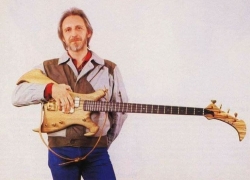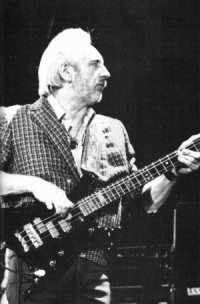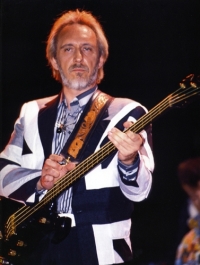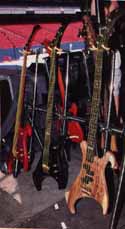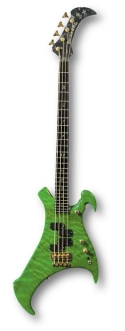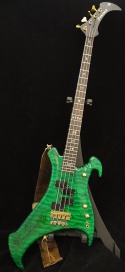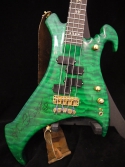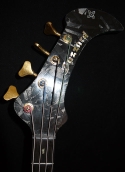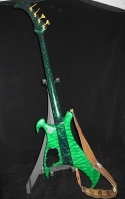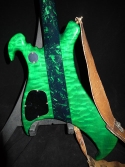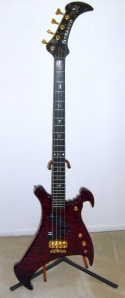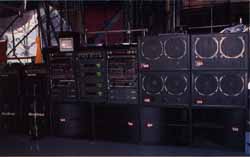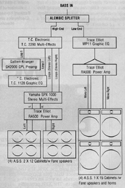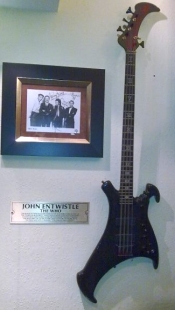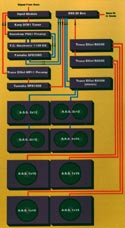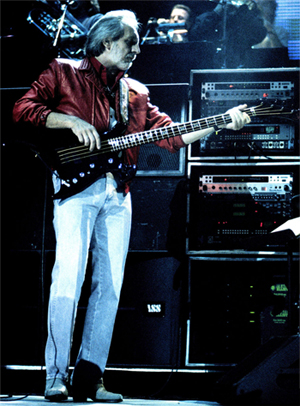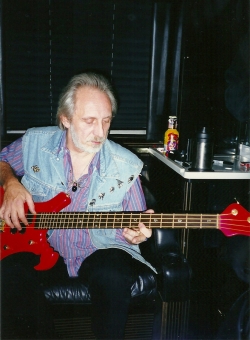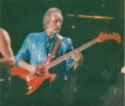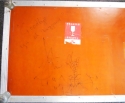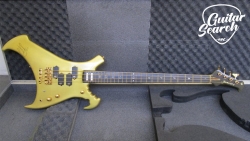John Entwistle’s Gear: 1986–2002
Buzzards and Little Manhattan
1986–1989
With the Who’s first post-1985 (Live Aid) activity at the Royal Albert Hall in 1988 for the BPI Lifetime Achievement Award induction, followed by the 1989 25th Anniversary tour, John changed his rig entirely, with the advent of the “Buzzard” bass, and what would become his “Little Manhattan” amplifier rig.
Bass Guitars – 1986–1989 (to 1996)
The “Buzzard”
The original Buzzard was designed by John and Warwick in 1985, with prototypes and the first models in wood. Following the 1989 tour, John then worked with Modulus Graphite, which made three graphite Buzzards for John. Modulus then manufactured six graphite necks for Warwick for use in John’s Warwick-made basses. (Below is an excerpt of the history of the Buzzard according to Warwick, from the now offline warwickbass.com/news/37.htm (offline)).
Excerpt from ‘The Ox and The Buzzard: The Early History,’ by Dale Titus
The genesis of the Buzzard has, over time, devolved into somewhat vague or contradictory accounts. To clear the record and get the real story, I sought out the help of Hans Peter Wilfer and Geoff Gould, two gentlemen who were sequentially involved with John Entwistle during the creation of his first Buzzard basses.
“It’s the most beautiful, ugly bass in the world”
Hans Peter Wilfer, the founder of Warwick basses, was approached by John Entwistle to create a special bass for him in 1985. John had some very unique ideas as to how the bass should look and play, so he sat down with Hans Peter and the two of them sketched out the design that the world knows today. Hans Peter came up with the idea of the distinctive “hand grip” on the lower horn, the stylized headstock and many other design specifics that make the Buzzard such a wonderfully unique bass. Then, after the basic body shape was agreed upon, Hans Peter and John sat in a London nightclub called Maggie’s and decided to name the bass the Buzzard. In all honesty, Hans Peter says that many drinks were consumed that night and he cannot remember exactly who thought of the name the Buzzard, but he thinks it was John’s idea. In the days that followed, Hans Peter then made a few prototypes for John to play and critique, and the design was further polished. It was after the duo decided on the name Buzzard, that the headstock was changed to more closely resemble the beak of said bird.
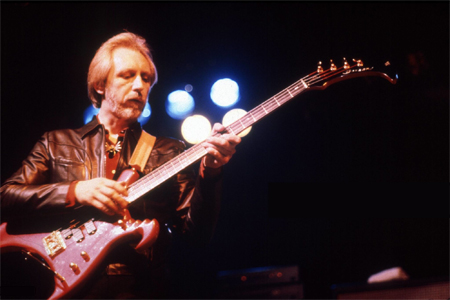
Ca. 1987, with Rat Race Choir, earliest use of a Warwick Buzzard.
After playing the Warwick-made Buzzard for a while, John became curious about the various benefits of graphite necks. He contacted his friend Geoff Gould, who was the president and founder of Modulus Graphite. John had known Geoff for quite some time and the two had worked together before, so he asked Geoff to make him some Buzzard basses with graphite necks, which he did. “What John was looking for was a combination of factors,” Geoff told me via email. “He liked the fact that the neck was relatively impervious to weather changes, since he liked to play with the strings so close to the frets, they were almost laying on top of them. This was quite difficult with a wood neck because it would necessitate constant truss rod adjustments. He also liked the sonic characteristics of the neck because his dynamic playing style, from the soft, deft touches to the thunderous hammering.” Modulus Graphite made at least two Buzzard basses for John, which he paid full retail for as a way to support Modulus. It was later that Modulus provided Warwick with six bass necks for them to use in the production of John’s personal Buzzard basses.
So, in regards to the first Buzzard basses that were made for John Entwistle, Hans Peter designed the body to John’s taste, and the original Buzzard took flight. Geoff and Modulus Graphite made the next few Buzzards for John, and later provided Warwick with graphite necks for John’s personal Buzzards.
warwickbass.com/news/37.htm (offline)
The models varied in features, including the “gun grip” lower horn, longer-style/shorter-style “buzzard beak” headstocks, inlays, LED necks, signature inlay at the 21st fret, etc.
-
Warwick

Click to view larger version. Gold sparkle Warwick Buzzard, courtesy RockStarsGuitars.

Click to view larger version. White Warwick Buzzard, courtesy RockStarsGuitars.
The Warwick Buzzard.
- Designed by John, featuring:
- 34″ long-scale neck, with neck-through-body, and Arabic numbered marker inlays, some with signature inlay.
- Two EMG P-bass split pickups (note: later reissue versions used MEC pickups).
- Early models with volume control set forward, and fader and EQ knobs back.
- Later models with all three controls grouped back, with the EQ as a stacked two-band EQ control.
- Early models wtih top-mounted jack; later models with side-mounted jack.
- Weight approximately 12 lbs.
- Warwick 8-string basses
- Bartonlini electronics
Photo Gallery
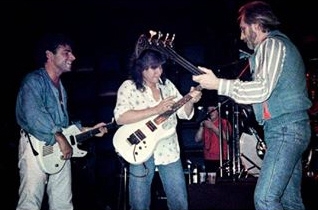
Ca. June 1986, at NAMM in Chicago, with Neil Schon and Eddie Van Halen, promoting the new Buzzard bass.
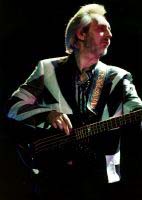
Ca. 1989, with Warwick Buzzard.
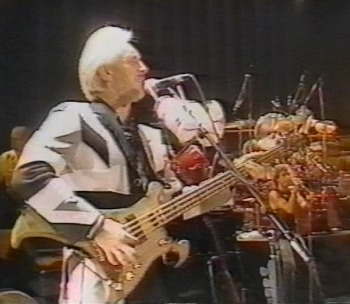
Ca. 1989, with Warwick Buzzard 8-string.
- Designed by John, featuring:
-
Modulus Graphite Buzzard
Following the 1989 tour, John then worked with Modulus Graphite, which made three graphite Buzzards for John. Modulus then manufactured six graphite bolt-on necks for Warwick for use in John’s Warwick-made basses.
-
Third prototype, in green, for which John paid full retail, and used on the Ringo Starr and His All-Starr Band tour in 1995.
Prototype, arabic numbers on fretboard, no serial number. From Bass Culture:
“Modulus Graphite made this prototype for me. Unlike all the other Buzzards, this one has no leds in the neck. I used this for almost every show on Ringo Starr’s All Star Tour of Japan and the USA.” Warwick Buzzard/Green
Sold in Sotheby’s 2003 auction; Estimated £2,000–£3,000; sold for £5,760.
-
The second Buzzard prototype by Modulus, also in green, was sold by Modulus to the Hard Rock Café.
Sale description: “Owned and played by John Entwistle of the Who. Prototype model (no serial number). As rare as it gets. Comes with John’s guitar strap and pendant as well. Signed by John Entwistle.”
-
The first Modulus Graphite Buzzard prototype is owned by Les Chambers.
Les Chambers:
Rich Hoeg, of Hoeg Guitars, worked for Modulus Graphite and he assembled all three Buzzards for John. I own the first Buzzard Modulus made. The second was sold to the Hard Rock Cafe, later auctioned, then sold to Cowtown, who sold it to the current owner. The third Buzzard is the one John purchased and took on tour and was eventually sold at the Sotheby’s auction in 2003.
According to Rich, “We made three for John from the Who. This one was the first, and the neck was too big. The second one, the body was too far forward in relationship to the neck. It was green, and we sold it to the Hard Rock Cafe. The third one was also green, we let John play it in our booth at the 1989 Winter NAMM show. I remember after playing it a bit he leaned over to me and said, ‘I like this one,’ and that’s the one he took to Japan and all over. We only made three. The body is quilted maple.”
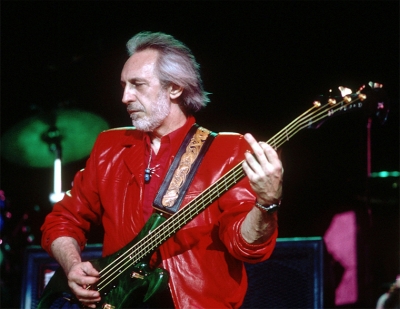
Ca. 1995, with 1991 green Warwick/Modulus Buzzard.
-
Selected quotes
All quotes and references are copyright their original owners and are included for reference only.
Quote from August 1989 Guitar Player
While scouting a Frankfurt, Germany, music show in search of a replacement for the Alembics, Entwistle came across Warwick basses. “First, they gave me a headless bass with Alembic pickups,” he recalls, “but the neck was too thin and I hate playing headless basses—it’s like falling off a cliff. Then I got one of their Thumb Basses, and it felt good, so I asked them to incorporate my specs into some prototypes.” The collaboration led to the creation of Entwistle’s Buzzard Bass, a bizarre instrument shaped like a cartoon bird, which features an ebony fingerboard, through-body neck, two sets of EMG P-Bass pickups placed opposite one another in the shape of a V, and such personal cosmetic touches as talons and a gun-style handle. “It’s the most beautiful, ugly bass in the world,” John smiles. “I’m bringing four 4-string Buzzards and a couple of 8-string models on the tour.
Quote from July 1989 interview in Musician magazine:
“I’ve designed a new bass guitar for Warwick called a Buzzard, a big, weird-shaped bass, similar in dimension to the Explorer basses I was using. But now it’s shaped like a flying buzzard. It reminds me of the Queen of Hearts in Alice in Wonderland playing croquet with a flamingo.”
Excerpt from November 1989 article in Guitar World magazine:
Entwistle uses both four- and eight-string basses built by Warwick. The four-stringers are called “Buzzards” and were designed by John himself. All are long scale and feature EMG P- and J-type active electronics. The eight-stringers are designed more conservatively and feature Bartonlini electronics. Lastly, the Ox uses Maxima gold-plated strings and changes them every day.
Amplification – 1986–1989
Following connecting with Trace Elliot at NAMM in 1987, John began using Trace Elliot amplifiers and compiling what would become Little Manhattan, with racks comprising various effects and Trace Elliot amplifiers, driving A.S.S. speakers.
Trace Elliot’s chief engineer and part owner was Mark Gooday, with whom John would develop a relationship and would go on to found Ashdown Engineering in 1997.
John’s rig consisted of three-way-split signal, bass-mono, bright left and bright right. Below are two considerably different descriptions of his rig.


Description 1 (from Guitar World)
- Treble/high-end signal
- Bass into Alembic splitter, into
- TC Electronic 2290 multi-effects processor (has five external effects loops, which allow it to function as MIDI controller)
- Loop 1: Linked to a Gallien-Krueger GK2000 CPL preamp;
- Loop 2: Connected to TC Electronic 1128 graphic equalizer;
- Loop 5: Linked to Yamaha SPX1000 stereo multi-effects unit;
- SPX1000 stereo output to the left and right channels of a Trace Elliot RA500 power amp
- Power amp feeds four (two each channel) A.S.S. 212 2×12 cabinets loaded with Fane speakers.
- Bass/low-end signal
- Bass into Alembic splitter, into:
- Trace Elliot MP11 Programmable Pre-amplifier graphic equalizer, sending a mono signal into:
- Trace Elliot RA500 power amp.
- Power amp drives four A.S.S. 1×15 cabinets with Fane speakers and horns.
Description 2 (from Guitar Player, August 1989)
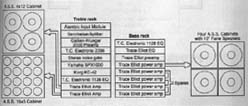
Click to view larger version. Alternate diagram of 1989 rig, by Rick Eberly, from Guitar Player, August 1989.
- Treble/high-end signal
- Instrument signal via Sennheiser wireless receiver, into
- Alembic preamp/splitter, into
- Gallien-Krueger 2000 preamp, into
- T.C. Electronics 2290 programmable delay
- (with an optional 64-second oversampling conversion)
- Acts as controller for other processors to recall programs
- Stereo noise gate (presumably BSS)
- Yamaha SPX 1000 digital effects processor
- Korg KEC42 (hum cancellation)
- T.C. Electronic 1128 programmable 32-band graphic equalizer
- Two Trace Elliot 300-watt power amps
- One amp powers one A.S.S. 4×12″ cabinet with Fane speakers
- One amp powers one A.S.S. 16×5″ speaker cabinet with Fane speakers
- Bass/low-end signal
- Instrument signal via Sennheiser wireless receiver (from above), into
- T.C. Electronic 1128 programmable 32-band EQ or Trace Elliot EQ (presumably Trace Elliot MP11 Programmable Pre-amplifier graphic equalizer)
- Trace Elliot (MP11) Programmable Pre-amplifier, into
- Trace Elliot (RA500) 500-watt power amp
- Power amp drives four A.S.S. 1×15″ cabinets with Fane speakers
The below control/power rack system tower diagrams have been reproduced and expanded upon from the former buzzardbass.com site, which is now offline. All images are generic.
| Item | Image |
|---|---|
| Alembic IN-2 Input Module | |
| Gallien Kreuger 2000CPL Preamp (with RFG5 remote foot controller) | |
| Korg DT-1 PRO Digital Tuner | |
| T.C. Electronic TC 1128 programmable 28-band graphic EQ/spectrum analyzer (x2) |
|
| Yamaha SPX 1000 Professional multi-effects processor | |
| T.C. Electronic TC 2290 Dynamic Digital Delay + Effects Control Processor (with TC 0144 serial remote controller) |
 |
| Korg KEC-42 EQ/Compander | |
| Trace Elliot MP11 Programmable Pre-amplifier |  |
| Trace Elliot RA300 Power Amplifier (x3) |  |
| Trace Elliot RA500 SX Power Amplifier (x4) |  |
| Trace Elliot UV illumination panels |
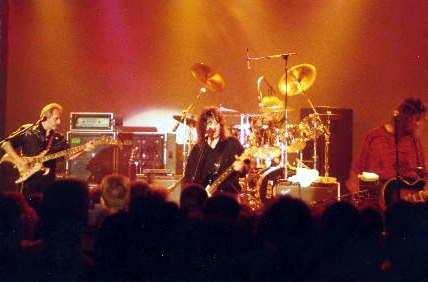
Ca. November 1987, with Rat Race Choir, using the Trace Elliot/A.S.S. rig, and Buzzard bass.
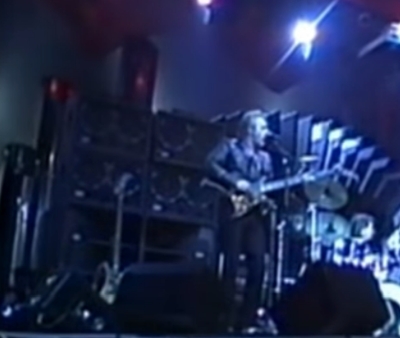
8 Feb. 1988, BPI Awards, with first use with The Who of the new Trace Elliot/A.S.S. rig and Buzzard bass, and last gig with Kenney Jones.
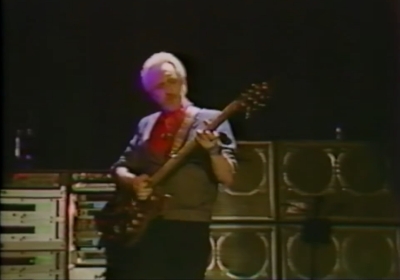
1989 rig, with Warwick Buzzard 8-string.
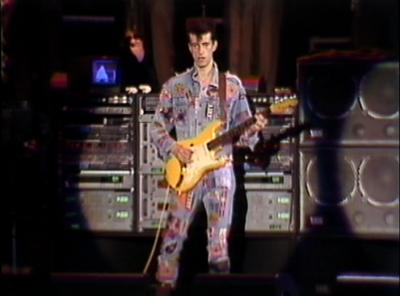
1989 rig.
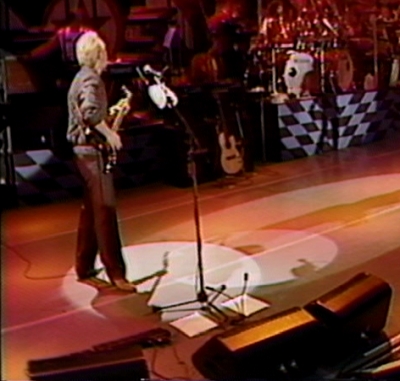
1989 pedal setup.
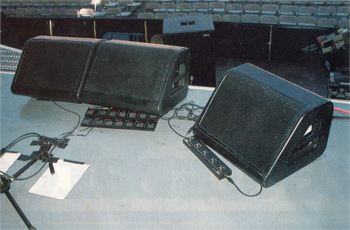
Click to view larger version. 1989 pedal setup, with T.C. Electronic TC 0133 or TC 0144 serial remote controller at left, Gallien-Krueger GK RFG5 remote foot controller at right.
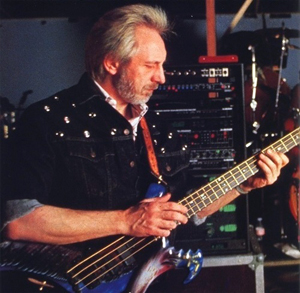
Click to view larger version. Rig detail as seen in Maxima Gold strings ad from Guitar World magazine, November 1989. Bass guitar is Warwick Buzzard with “buzzard” image finish.
Selected quotes
All quotes and references are copyright their original owners and are included for reference only.
Quote from July 1989 interview in Musician magazine:
“Since the last time I played with the Who, I’ve changed absolutely everything, except the basic idea of sound splitting. All I have to do is press a footswitch and the whole thing changes. I couldn’t find one amplifier manufacturer who made all I wanted, so it starts with a t.c. electronics digital delay that controls all the outboard stuff. The Yamaha SPX1000 gives me a lot more effects and splits into a stereo chorus. I’ve got a Gallien-Krueger 2000 CPL preamp, which I use to get a beefy overdrive. I’ve got the top sound, the distorted trebly guitar sound, coming out of four 12s and 16 fives in stereo. That goes into two Trace Elliot 500W power amps. I’ve got a Trace Elliot computer preamp for the bottom end, or I can use a t.c. graphic EQ, whichever I favor at the time, going through four 15s. All the speakers are Fanes in A.S.S. English cabinets.
Quote from 1994 interview with John:
- I noticed in ’89 you had amps behind you that said something like Acoustic Sound System?
Acoustic [Sound] Services — A.S.S. They’re a company in England. They make all those cabinets. They make those specially, a rig for me.
- I was wondering if it was your own line of amps or cabinets.
No, they’re sold commercially, but they’re a very small company in South End in England. They used to make stuff like TurboSound by JBL. It’s just that their cabinets give you a very directional, perfect sound. The bottom end is very tight, top end’s very smooth. I haven’t found any other cabinets like them that last that long. I use exactly the same speakers that I use in those cabinets in other cabinets and they blow to smithereens.
- If I were the company I’d be very happy to have that sort of recommendation.
Well I’ve done this tour, I’ve done a club tour, done a tour of sheds, done a couple of stadium tours with The Who with them, and I haven’t blown one speaker yet.
Quote from August 1989 Guitar Player
“I use the distortion from the Yamaha SPX1000 combined with the natural distortion of the overdriven Gallien-Krueger preamp, which gives me long sustain even at lower volumes. I have various choruses, exciters, echoes, and delays on at all times. They’re programmable and all go through the treble side only. I’ve already programmed 10 of the Who songs for the tour, and will probably use the sampler to play back the bass lines during my big solo feature in ‘Shakin’ All Over,’ where I play with the drums and then cue them out to do a free-form thing.”
Entwistle’s setup consists of two racks: one for treble and one for bass frequencies. His instrument signal reaches the treble rack via a Sennheiser wireless reciever, where it is split and sent to the treble rack’s Alembic preamp, as well as to the bass rack’s input.
The signal then goes to a Gallien-Krueger 2000 preamp, followed by a T.C. Electronics 2290 programmable delay with an optional 64-second oversampling conversion that allows sampling and endless-loop playback of up to three bass parts, enabling Entwistle to play along. The 2290 also acts as a controller to recall programs on the other processers. A stereo noise gate cuts the grit and hiss, followed by a Yamaha SPX 1000 digital effects processor, a Korg KEC42 for removing hum, and a T.C. Electronic 1128 programmable 32-band graphic equalizer. The treble rack also has two Trace Elliot 300-watt power amps; one drives an A.S.S. 4x12 cabinet and the other powers an A.S.S. cabinet with 16 5” speakers. Both cabinets house Fane speakers. John’s bass rack offers a choice of a T.C. Electronic 1128 programmable 32-band EQ or Trace Elliot EQ, followed by a Trace Elliot preamp and a Trace Elliot 500-watt power amp that drives four 1x15 A.S.S. cabinets equipped with Fanes.
Excerpt from November 1989 article in Guitar World magazine:
Equipment manufacturers are no doubt thrilled to see John Entwistle, the Who’s chief gear hound, back on the road again. Initial reports that he would be using two racks—one for bottom and one for bright signals—have been proven false. Instead, he’s splitting his bass signal three ways: a bass-mono, a bright left and a bright right.
His treble signal runs from an Alembic splitter unit to a TC Electronics 2290 multi-effects processor. In addition to its internal studio-quality effects, the 2290 has five external effects loops which allow it to function as a MIDI controller. Of the five loops, John uses three. Loop One is linked to a Gallien-Krueger GK2000 CPL preamp; Loop Two is connected to a TC Electronics 1128 graphic eq; and Loop Five is linked to a Yamaha SPX1000 stereo multi-effects unit. The outputs of the SPX1000 go to the left and right channels of a Trace Elliot RA power amp, driving four 2 × 12 speaker cabinets (two on the left/two on the right). By isolating his bright signal, Entwistle is able to utilize the guitar-like aspect of his sound to its fullest potential.
His low-end signal runs from the Alembic directly to a Trace-Elliot MP11 graphic eq that sends a mono signal to an additional Trace-Elliot RA500 power amp. The RA500 drives four A.S.S. 1 × 15 Cabinets with Fane speakers and horns. This separation of his high- and low-end signals allows John to maximize the thunderous quality of his bottom-end without interfering with the clarity and definition of his bright signal.
Excerpt from April 1995 Bassist interview
- How did he discover [Trace Elliot]?
“Through the Bass Centre in Wapping. I went there out of interest, because I saw an ad in one of the music papers and thought that if there was a shop dedicated to bass equipment then I should definitely take a look! They had a lot of Trace Elliot gear there. I got invited to one of the American trade shows by Henry Goldrich who owns Manny’s in New York. He said that the trade shows were great events for getting drunk and talking about music all day. Sounded good to me! That was when I really formed the link with Trace Elliot. I found that the best bottom end I could get was through one of their computerised graphic preamps that has 20 built-in programs. They want one back so they can start making them again, but I’ve got all of them! I now use Trace MP60 power amps but also a lot of different stuff on top of that, like a Sansamp preamp, a buch of TC Electronic gear and Yamaha SPX1000s. I’ve found the SPX is the best for giving harmonic distortion when I’m tapping the strings.”
1996–2002
Bass Guitars – 1996–2002
-
Status Graphite Buzzard bass guitars

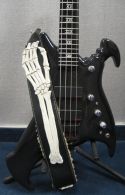
Click to view larger versions. Status Graphite Buzzard bass prototype (with no serial number); has one gold tuning key and three black ones, along with four chrome pots (potentiometers; one is a stacked treble/bass control) instead of five as in the production version. Courtesy Brad Rodgers, whocollection.com.
Status Graphite was the third company John worked with on the Buzzard concept, following Warwick and Modulus, and developed the all-graphite one-piece Status Graphite John Entwistle Buzzard model for John.
- One-piece, all-graphite body
- Graphite neck (with slimmer profile than the Warwick Buzzard’s neck)
- 26-fret phenolic fingerboard, with roman numeral fret marker inlays.
- Hipshot Bass Xtender (for instant drop-D tuning)
- Five 9-volt batteries (two for the 18-volt preamp; three for the LEDs in the neck)
- Weigh approximately 9 lbs.
- All fitted with different coloured hardware so John and techs could tell them apart (e.g., one gold tuning key with three black; all gold; black with chrome; all chrome; etc.)
First known live use was 29 June 1996, at Hyde Park, as John was still using Warwick Buzzards on his 1996 solo tour.
Status Graphite offered signature retail versions of the Buzzard model in 1998.
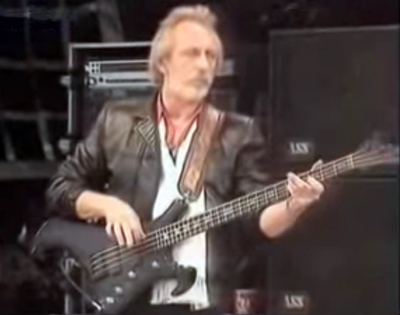
29 June 1996, Hyde Park, John with Status Graphite Buzzard Bass and ASS amp rig.
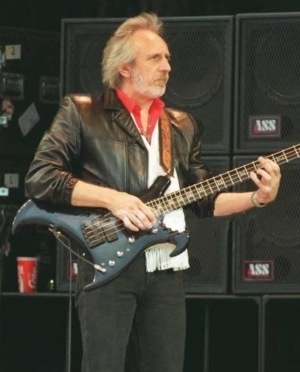
29 June 1996, Hyde Park, John with Status Graphite Buzzard Bass and ASS amp rig.
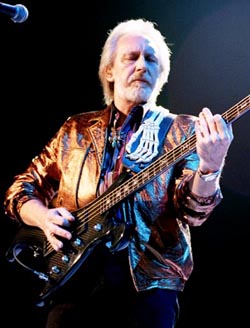
Ca. 2000, with Status Graphite Buzzard Bass.
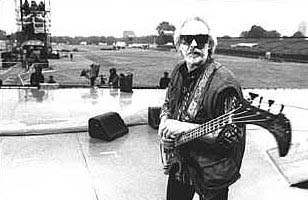
Ca. 2000, with Status Graphite Buzzard.
-
Taylor AB-1 acoustic bass
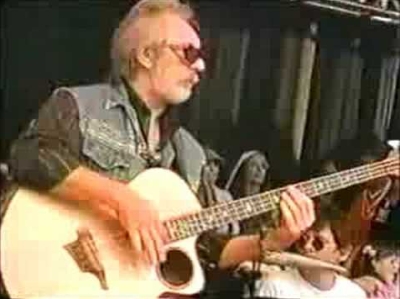
Ca. October 1999, with Taylor AB-1 acoustic bass.
For the October 1999 Bridge School Benefit shows only, John used a Taylor AB-1 acoustic bass, amplified through Little Manhattan.
“It’s pretty tricky this time because there’s an acoustic set and I’ve never played acoustic bass, once on stage, one of Roger’s concerts. Playing acoustic is very difficult for me, because I have no control of what it’s going to sound like.”
Amplification – 1996–2002

From the Quadrophenia shows in 1996 through John’s final performance in 2002, his amplifier rig — “Little Manhattan” — were variations on using dedicated split signals for highs and lows, first based around Trace Elliot amplifiers and A.S.S. speakers, then, when Mark Gooday left Trace Elliot in 1997 following the company’s 1992 sale to Kaman, and in 1997, founded Ashdown Engineering, and formed a close relationship with John. Ashdown began making amplifiers and the same A.S.S. speakers for John.
For solo performances, John used similar but expanded versions of his Who rigs.
1996–1997 – Quadrophenia tour
- Amplifiers
- Top rack
- Korg/Tone Works DTR-1 digital tuner
- Tech 21 SansAmp NYC model PSA-1
- TC Electronic TC1128 programmable 28-band graphic EQ/Spectrum Analyzer
- Two Yamaha SPX 1000 Professional multi-effects processors
- Trace Elliot MP11
- Alembic IN-2 input module
- Middle rack
- Same as top rack, with only one Yamaha SPX 1000; for backup/spare.
- Bottom rack
- Three Trace Elliot RA500 SX power amplifier output stages.
- TC Electronic TC 0133 Serial Remote Controllers, to split the mono signal into two frequency ranges.
- Low range sent to TC1128 Graphic EQ > RA500 SX output stage > driving two A.S.S. 115 1×15″ horns
- Upper range sent to SansAmp > TC1128 Graphic EQ > SPX 1000 > RA500 SX output stage > driving two A.S.S. 212 2×12″ cabinets.
- BSS DI to PA
- Top rack
- Speakers
- Two A.S.S. 212 2×12″ reflex bass cabinets.
- Two (with The Who) or four (with the John Entwistle Band) A.S.S. 115 1×15″ flared bass bins.
The below control/power rack system tower diagrams have been reproduced and expanded upon from the former buzzardbass.com site, which is now offline. All images are generic.
| Item | Image |
|---|---|
| Korg/ToneWorks DTR-1 Digital Tuner | |
| Tech 21 SansAmp NYC model PSA-1 | |
| T.C. Electronic TC 1128 programmable 28-band graphic EQ/spectrum analyzer | |
| Yamaha SPX 1000 Professional multi-effects processor (x2) | |
| Trace Elliot MP11 Programmable Preamplifier |  |
| Alembic IN-2 Input Module | |
| Trace Elliot RA500 SX Power Amplifier (x3) |  |
1999
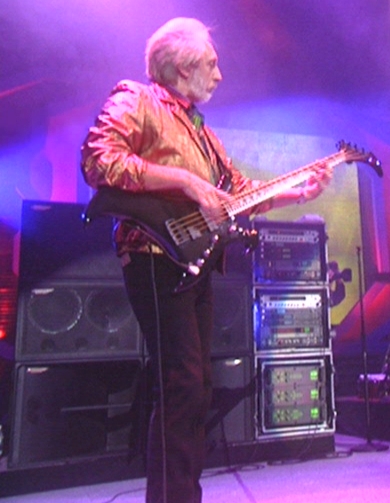
Ca. 1999, John with Status Graphite Buzzard Bass and amp rig.
For the Who’s 1999 reunion dates, starting in October, Ashdown Engineering, which was founded in 1997 by Mark Gooday following his departure from Trace Elliot, made custom versions of the ASS speakers for John, ABM ASS 212 2×12″cabinets and ABM ASS 115 1×15″ bins, with first use at Las Vegas on 29 Oct.
- Amplifier rig same as 1996–97, with SansAmp PSA-1 and Trace Elliot EQ and power amplifiers.
- Ashdown takes over from A.S.S., and produced identical cabinets as above for John.
- Two Ashdown Engineering ABM ASS 212 2×12″ reflex bass cabinets, designed for John (see Ashdown.co.uk (archived)).
- Two (with The Who) or four (with the JEB) 600-watt Ashdown Engineering ABM ASS 115 1×15″ flared bass bins, designed for John (see Ashdown.co.uk (archived)).
In 1999 for solo gigs, it is also reported that for John’s eight-string bass setup, he was using one Trace Elliot power amp per bass string! (i.e., eight power amps!). (Thanks to Ray Davis (abbeyrhode.com), whose band at the time, Blueblood, opened for the JEB at the Last Call, in Providence, RI, 22 July 1999.)
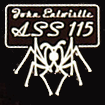
2000–2001
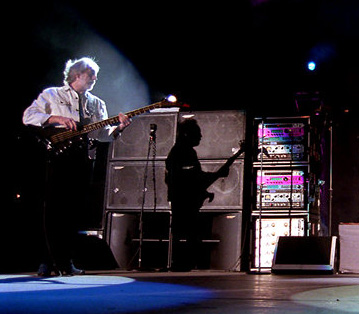
Ca. 2000, John with Status Graphite Buzzard Bass and amp rig.
For the Who’s 2000 tour, and lone 2001 gig at Madison Square Garden, Ashdown Engineering had built custom amplifiers for John.
He debuted the use of Ashdown at a benefit gig on 6 May 2000, using an ABM EVO 900 amplifier head paired with a Gallien-Krueger 250RL amplifier, driving two ABM ASS 212 2×12″ and one ABM ASS 115 1×15″.
- Ashdown Engineering RPM-1 Bass Pre-Magnifier preamps
- Features: tube and solid state preamp section, flexible 7-band EQ, a subharmonic processor as well as onboard crossover.
- One Ashdown Engineering PM600 Power Amp
- Three Ashdown Engineering PM1000 Power Amps (one as spare)
- DigiTech 2120 Artist Series Valve Guitar System programmable pre-amp processor, fed into RPM-1 preamp’s effect loop for chorusing and overdrive.
- Distorted highs run from the PM600 into two Ashdown Engineering ABM ASS 212 2×12″ reflex bass cabinets, designed for John (see Ashdown.co.uk (archived)).
- PM1000’s lows sent to two (with The Who) or four (with the JEB) 600-watt Ashdown Engineering ABM ASS 115 1×15″ flared bass bins, designed for John (see Ashdown.co.uk (archived)).
In 2001, Ashdown Engineering introduced retail versions of its John Entwistle signature items.
The below control/power rack system tower diagrams have been reproduced and expanded upon from the former buzzardbass.com site, which is now offline. All images are generic.
| Item | Image |
|---|---|
| Korg/ToneWorks DTR-1 Digital Tuner | |
| Digitech 2120 Artist Valve Guitar System |  |
| Digitech Studio Quad 4 Effects Processor | |
| T.C. Electronic TC 1128 programmable 28-band graphic EQ/spectrum analyzer | |
| Ashdown Engineering RPM1 Bass Pre-Magnifier |  |
| Alembic IN-2 Input Module | |
| Ashdown Engineering PM600 Power Amplifier |  |
| Ashdown Engineering PM1000 Power Amplifier (x4) |  |
2001 (solo)
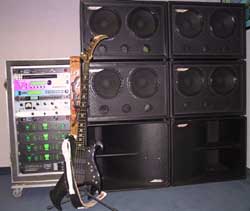
Click to view larger version. John’s rig, ca. 2002, courtesy Brad Rodgers, whocollection.com.
- Four Ashdown Engineering ABM ASS 212 2×12″ reflex bass cabinets
- Two Ashdown Engineering ABM ASS 115 1×15″ flared bass bins
- Control rack mounted in flight case consisting of:
- Furman PL Plus Power Conditioner & Light Module
- Korg Tone Works Large Display Tuner
- Digitech 2120 Artists Series Valve Guitar System programmable preamp processor
- Digitech Studio Quad 4: 4-in 4-out multi-effects processor
- TC 1128 programmable 28-band graphic EQ/spectrum analyzer
- Ashdown Engineering-Klystron Bass Pre-Magnifier
- Custom-designed input router.
- (Another) Furman PL Plus Power Conditioner & Light Module
- Four Trace Elliot PPA 600 Professional Power Amps
- Furman Power Conditioner AC line regulator model AR-Pro
- Five flight cases for speaker cabinets and Control/Power rack
From Bass Player, October 2001:
Entwistle used only half his usual mountain of gear, but his trademark tone—clear and growly with ringing, piano-string fundamental—was in full force, thanks to his signature Status Buzzard Series 1 and 2 basses and an Entwistle signature Ashdown RPM-1 preamp. He runs his highs through an Ashdown PM-600 power amp to two Ashdown ASS-212 2×12 cabs; his lows flow through an Ashdown PM-1000 power amp to two Ashdown ASS-115 1×15 cabs. For overdrive and chorus, he runs a DigiTech 2120 Artist guitar preamp into the RPM-1’s effect loop. “For this tour, I have to back off the treble,” says Entwistle, who joked about soaking his calluses to get a rounder sound.
The below control/power rack system tower diagrams have been reproduced and expanded upon from the former buzzardbass.com site, which is now offline. All images are generic.
| Item | Image |
|---|---|
| Furman Sound PL-Plus Line Conditioner | |
| Korg DTR-1 Tuner | |
| Digitech 2120 Artist Valve Guitar System |  |
| Digitech Studio Quad 4 Effects Processor | |
| T.C. Electronic TC 1128 programmable 28-band graphic EQ/spectrum analyzer | |
| Ashdown Engineering RPM1 Bass Pre-Magnifier |  |
| A/B Input module | |
| Furman Sound PL-Plus Line Conditioner | |
| Trace Elliot PPA 600 Professional Power Amplifier (x4) |  |
| Furman Sound AR-Pro AC Line Voltage Regulator |  |
2002
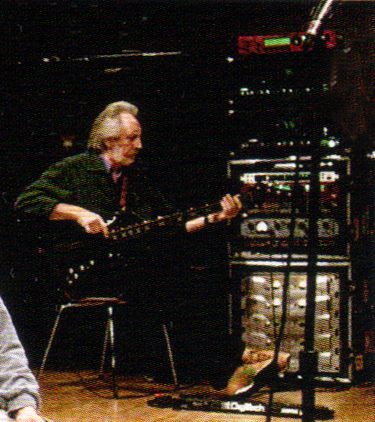
Ca. June 2002, in rehearsals, John with Status Graphite Buzzard Bass and amp rig. Digitech foot controller on the floor in front.
- One Ashdown Engineering RPM-1 preamp
- Features: tube and solid state preamp section, flexible 7-band EQ, a subharmonic processor as well as onboard crossover.
- One Ashdown Engineering PM600 power amp
- Three Ashdown Engineering PM1000 power amps (one as spare)
- Trace Elliot V8 400-watt amp (for midrange)
- DigiTech 2120 Artist Series Valve Guitar System programmable pre-amp processor, fed into RPM-1 preamp’s effect loop for chorusing and overdrive.
- (John also experimented with a Line 6 POD Pro guitar unit (for distortion) in place of the DigiTech 2120, fed into RPM-1 preamp’s effect loop for chorusing and overdrive.)
- Distorted highs run from the PM600 into two Ashdown Engineering ABM ASS 212 2×12″ reflex bass cabinets.
- Midrange sent to two Ashdown Engineering ABM ASS 212 2×12″ reflex bass cabinets.
- PM1000’s lows sent to two 600-watt Ashdown Engineering ABM ASS 115 1×15″ flared bass bins.
- Two Ashdown Engineering ABM 810 8×10″ cabinets laid on side (see Ashdown.co.uk (archived)).
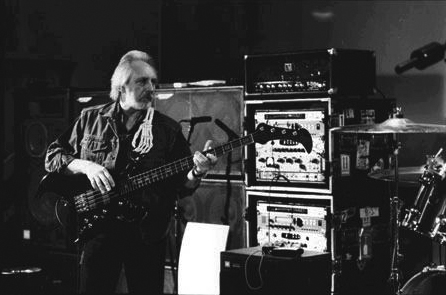
Ca. June 2002, in rehearsals, John with Status Graphite Buzzard Bass and amp rig, topped by one Trace Elliot V8, with Line 6 Pod Pro in both racks above the Ashdown RPM1, replacing the Digitech Studio Quad 4 and TC Electronic EQ.
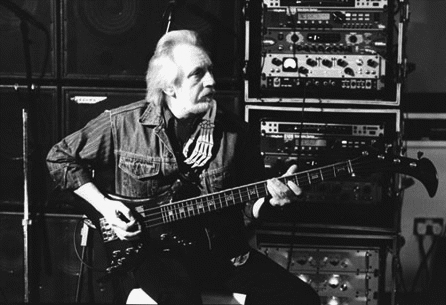
Ca. June 2002, in rehearsals, John with Status Graphite Buzzard Bass and amp rig, with Line 6 Pod Pro in both racks above the Ashdown RPM1, replacing the Digitech Studio Quad 4 and TC Electronic EQ.
The below control/power rack system tower diagrams have been reproduced and expanded upon from the former buzzardbass.com site, which is now offline. All images are generic.
| Item | Image |
|---|---|
| Trace Elliot V8 400-watt amp (for midrange) (x2) | 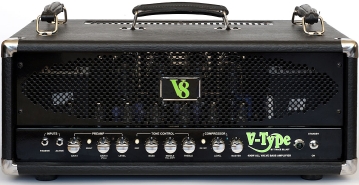 |
| Korg/ToneWorks DTR-1 Digital Tuner | |
| Digitech 2120 Artist Valve Guitar System |  |
| Digitech Studio Quad 4 Effects Processor | |
| T.C. Electronic TC 1128 programmable 28-band graphic EQ/spectrum analyzer | |
| Ashdown Engineering RPM1 Bass Pre-Magnifier |  |
| Line 6 Pod Pro (used in rehearsals only) |  |
| Alembic IN-2 Input Module | |
| Ashdown Engineering PM600 Power Amplifier |  |
| Ashdown Engineering PM1000 Power Amplifier (x4) |  |
Trace Elliot V-Type V8 Bass amp
Trace Elliot V-Type V8 valve bass amplifier head previously owned by John Entwistle, and used as a spare. 230 VAC. 400 watts RMS into 2 or 4 ohms. Courtesy Ron Knights of the UK band Quench (quenchuk.com (offline)), and whocollection.com. Sold via ebay auction March 2004 for £800.
Selected quotes
All quotes and references are copyright their original owners and are included for reference only.
From December 1996 Total Guitar interview
- [Regarding the June 1996 Hyde Park Quadrophenia performance] You were playing your Buzzard bass…
“Yeah, it’s a Status Buzzard and I had the two prototypes with me on that gig. It’s completely graphite, a one-piece mould. But the second one caved in on me. They are, or were, absolutely identical in every way; they feel and sound the same, so I had to put a different colour hip shot on each of them so I could tell the difference. It has the same electronics as a normal Buzzard, but they are currently desiging a proper circuit board for it. When they have finished that they are going to repalce the ones in mine. I wanted them to adjust the sweep parametric mid-range EQ on the bass, so that it sounded like a wah when I turned the knob, and it took them a while to get that right.”
- And you were also using ASS cabinets.
“Yeah, I’ve been using those for about 10 years. Originally I had eight 15″ and 16 12″, but I took them into ML Executives’ warehouse in Shepperton and played a few notes through this rig, and every piece of equipment in the place began vibrating like hell!
“So I thought, ‘No, this is too powerful, even for me!’ So I cut the system in half, including the amps, sent half over to America and kept the rest in England. I’m still using my Trace Elliot 500 amps and a Trace computerised graphic pre-amp. My main effects sound comes from a SansAmp, and on top of that in my rack I have a TC graphic EQ to add some presence on the top, and then the Yamaha SPX.”
“… On the next shows, we’re trying to take the stage volume level down so we can hear each other properly. In-ear monitoring is an interesting idea but it wouldn’t work for me unless I could have something on my feet to give me the vibration I need.”
From 15 May 2002 Guitar Center interview
- GC: Tell us about your current bass rig.
John: I’ll start at the bottom and work my way up. Rather than use a cross over type system, I use three separate amplifier systems: one for bottom, one for the mid and one for top.
At the bottom end I use an Ashdown signature model, ABM RPM1 (my signature), which is a Klystron Bass Pre-Magnifier powered by an Ashdown PM1000 power amplifier. This is running two Ashdown 8 × 10 cabinets. At the mid range, I use a Trace Elliot V-Type V8 valve amplifier going through two 2 × 12″ Ashdown JE cabinets. On the top end it gets even more complicated: to obtain treble and sustain at low volume, I use a Line 6 POD Pro programmable pre-amp or a Digitech 2120 Artist Valve Guitar System. These are powered by another Ashdown PM1000 power amplifier going in stereo into another two 2 × 12″ JE speaker cabinets with Ashdown Blue 12″ drivers.
My guitar plugs into a converted Alembic input module with an A/B guitar switch to enable smooth guitar changes. The input module has 4 outputs, one to each amp system and the fourth to a Korg DTR Digital Tuner. This is the current system I use with The Who. With my own band, JEB (the John Entwistle Band), the system is pretty much the same, only the bottom end speakers are four Ashdown JE ASS 15″ cabinets powered in mono by two Ashdown PM1000 power amplifiers. I carry two spare speaker cabinets for each system and two spare racks for both the pre-amps and the amps. A spare for the spare — just to be safe. Guitar wise, I carry four Status Buzzard four-string basses totally made of graphite to my own design and two Status Buzzard eight-string basses.
- GC: You’ve gone through quite a few makes and models of amps over the years. Can you take us through the high points of your amp history.
John: I started out with an 18″ speaker, which lived in an open-back cabinet. The rest of the band (we had no roadie at the time) objected to the heaviness of the cabinet with the 18″ inside it. So we had the idea to hang the speaker on a six-inch nail and carry it in a separate cardboard box. Consequently every time I played a low E note the speaker would vibrate off the nail and fall on the floor behind the cabinet. I guess I learned how to play with just my left hand in this way – as I needed the right to hang the damn speaker back on the nail!
After that, I went through a whole collection of different 50-watt amps and different speakers until, contrary to popular belief, Marshall made the first 4 × 12″ speaker cabinets. I bought the second, fifth, eighth and ninth. We insisted to Marshall that we needed a 100-watt amplifier for more power. They insisted it was impossible, but made one anyway. Pete and myself bought the first four.
From there, we changed to HiWatt 100-watt amps and 4 × 12″ cabinets. I eventually changed to using Sunn 300-watt Coliseum Amps powering four 18″ PA bins plus additional 12″ cabinets (up to sixteen 12″ cabinets at one point). After hundreds of different speakers and pre-amp changes, I discovered a guy who made me my present ASS speaker cabinets. These were later taken over by Mark Gooday at Ashdown who is currently making the same cabinets.
We were gradually playing larger venues and in the early days PA systems were kind of non-existent. So to play loud, we had to use louder equipment. The PA systems back then didn’t mic the instruments — only the vocals.
Later I had to use different amplification (e.g. pre-amp and processor to sustain at lower volumes as my big amps were tending to drown out the PA).
With bass, especially bottom end, the vibration has to happen on stage otherwise the feel is wrong. This is why you can’t scale the equipment down too far.
Mark Gooday, on the founding of Ashdown and building John’s first Ashdown amplifier:
“For the first three years I actually ran the company out of my dining room, had the cabinets made in Malden and made the PCBs at the back of my house. I can vividly remember sitting up, watching TV at three in the morning, building John Entwistle’s first amp, for his birthday, then driving it there for nine or ten the next morning and finding that he didn’t get up till three or four!
“All these old friends got in touch, like John and like Mark King. John Entwistle helped me in so many ways — he really did help to start the company.”

29 June 1996, at Hyde Park, John with Status Graphite Buzzard Bass and amp rig.
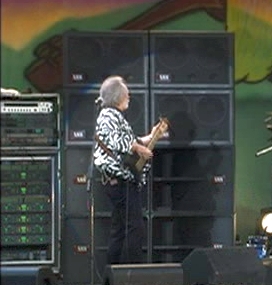
Ca. August 1999, John Entwistle Band solo performance with Status Graphite Buzzard Bass and towering amp rig.
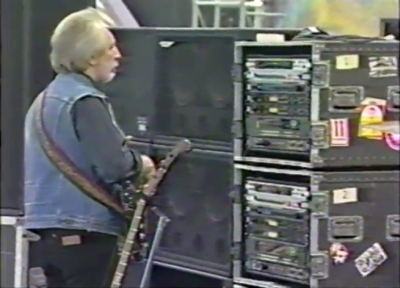
Ca. October 1999, John with Status Graphite Buzzard Bass and amp rig.
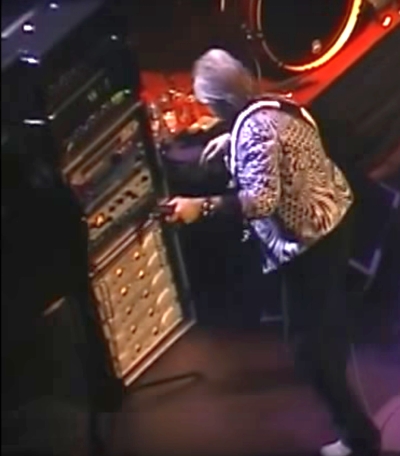
8 Feb. 2002, Royal Albert Hall, and John’s final performance with The Who, Status Graphite Buzzard Bass and amp rig.
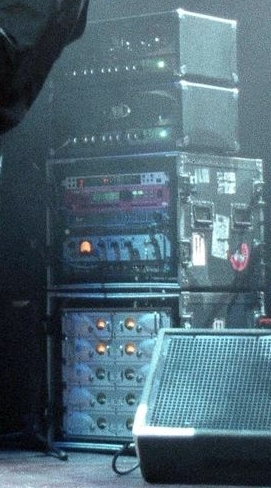
8 Feb. 2002, Royal Albert Hall, and John’s final performance with The Who, detail of amp rig.
Auction Profiles
All auction information, including quotes and references are copyright their original owners and are included for reference only. Whotabs makes no claim that these auctions represent authentic Who-used items.
News (May 2010): Christie’s to auction four lots of John’s amplifier rig, as part of its Popular Culture: Rock and Pop Memorabilia sale, to be held on 24 June 2010. The items are currently owned by Brad Rodgers of whocollection.com.
Rock Stars Guitars for sale at Christie’s
Lot 184: The control/power rack system tower used 2000–2002.
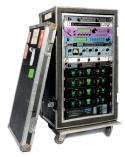
Click to view larger version. Lot 184: The control/power rack system tower used 2000–2002, from the collection of Brad Rodgers of whocollection.com.
- A Control/Power rack system tower, comprising of several components; two Furman PL power conditioners and light modules; Korg Tone Works large display tuner; Digitech 2120 artists series valve guitar system programmable pre-amp processor; Digitec Studio Quad 4, 4in 4out multi-effects processor; TC1128 programmable 28 band graphic EQ/Spectrum Analyzer; Ashdown Engineering krystron Bass pre-magnifier; Furman Power Conditioner AC line regulator model AR-pro; and four Trace Elliot professional power amps PPA 600s, in flight case — owned and used by John Entwistle whilst performing with The Who and The John Entwistle band, 2000; accompanied by a copy of a letter detailing the provenance, flight case dimensions — 24½×24½×47in. (62×62×120cm.)
- Estimated £2,000–3,000 (US$3,100–4,500; €2,300–3,400). Realised: £1,500 ($2,244).
Lot 185: Two sets of Ashdown 2×12 cabinets and flight cases, used 2000.
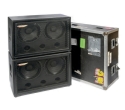
Click to view larger version. Lot 185: Two sets of Ashdown 2×12 cabinets and flight cases, used 2000, from the collection of Brad Rodgers of whocollection.com.
- Two sets of 2×12 Ashdown engineering speaker cabinets, upside down Ashdown logos to front, two flight cases; used by John Entwistle during live performances with The Who and the John Entwistle Band, 2000; accompanied by a copy of a letter concerning the provenance, Cabinet — 14×20×30in. (36×51×76cm.), flight case — 33×33×32in. (84×84×81cm.)
- Estimated £1,000–2,000 (US$1,600–3,000; €1,200–2,200). Realised: £750 ($1,122).
Lot 186: Two Ashdown 1×15 bins and flight cases, used 2000.

Click to view larger version. Lot 186: Two Ashdown 1×15 bins and flight cases, used 2000, from the collection of Brad Rodgers of whocollection.com.
- Two 1×15 Ashdown Engineering speaker cabinets, upside down Ashdown logos to front, two flight cases each with THE WHO stencilled in white on the top; used by John Entwistle during live performances with The Who and the John Entwistle Band, 2000; accompanied by a copy of a letter concerning the provenance, flight case — 33×33×32in. (84×84×81cm.)
- Estimated £1,000–1,500 (US$1,600–2,300; €1,200–1,700). Realised: £325 ($486).
Lot 187: Trace-Elliot V-Type V8 all-valve amplifier. Used as spare, 2000.

Click to view larger version. Lot 187: Trace-Elliot V-Type V8 all-valve amplifier. Used as spare, 2000, from the collection of Brad Rodgers of whocollection.com.
- A Trace Elliot V-Type V8 all valve bass amplifier head, serial number TO136/69/400, with flight case — used by John Entwistle on the last Who tour as a spare 230 VAC. 400 watts RMS into 2 or 4 ohms; accompanied by a letter concerning the provenance
- Estimated £600–800 (US$910–1,200; €680–900). Realised: £875 ($1,309).
See christies.com
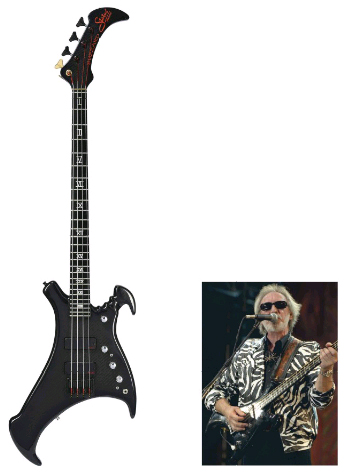
News (June 2012): Christie’s to auction Status Buzzard as part of its Popular Culture: Rock & Roll Memorabilia sale, to be held on 12 June 2012. The instrument is currently owned by Brad Rodgers of whocollection.com.
The Who
A circa 1996 Status Buzzard Prototype; No serial number, in black basket weave finish, irregular shaped carbon graphite body, chrome parts, irregular shaped headstock with a de-tuner and Status Graphite Buzzard in red, graphite neck, twenty seven fret graphite fingerboard with roman numeric position markers and LED side markers, two Hyperactive pickups, four rotary controls, two toggle switches, black bridge plate with four adjustable saddles; and an original aluminium framed rectangular flight case — owned and played by John Entwistle, during tours with The Who and The John Entwistle Band, and seen in performances at the Royal Albert Hall, 2000 and 2002; accompanied by a letter from the drummer/producer of the John Entwistle band concerning the provenance.
Estimate:
£10,000–£15,000 (US$15,440–$23,160)
Realised:
£13,750 (US$21,258)
Provenance:
Ex-lot 112 John Entwistle Estate Sale, Sotheby’s London, 13th May, 2003
From the collection of Brad and Diana Rogers [sic] of www.whocollection.com
Exhibited:
The Rock & Roll Hall of Fame, Cleveland, Ohio, from 1998–2007
See lot details at christies.com
1985 Warwick Buzzard offered for sale
A broken and repaired 1985 Warwick Buzzard of John’s was offered for sale in 2014 via eBay for US $32,500.
Sale description via eBay (offline):
A piece of Rock n’ Roll history — from John Entwistle’s personal collection the Warwick “Pink Buzzard” in a red metallic finish (circa 1985). Gorgeous bass guitar with signed custom hardshell case and an Entwistle spider doodle. The bass plays and looks great, the Illuminated side dots added a little extra flare and visibility while on stage.
This bass has a huge crack down the middle and back. As the lore goes, while on tour in the mid 90’s, Roger Daltry asked Entwistle to turn his bass down. In true rock and roll fashion, Entwistle threw the bass at Daltry and said, “you play the F***in’ thing”, as the bass hit the ground it cracked right down the middle.
- Machineheads: Warwick machine heads
- Nut: Just-A-Nut Brass
- Neck Wood: Zebrano and Wenge neck
- Fretboard: Wenge fingerboard
- Inlay: Numbers and stars inlays
- Fluorescent Side Dot: Illuminated Side Dots
- Fingerboard Radius: 20″
- Scale length: Scale lenght: 34″ (long scale)
- Fret quantity material and size: 26 Jumbo Bronze (extra hard) frets (Width: 2.9 mm / Height: 1.3 mm)
- Body Shape: Curved Body Shape
- Bodywood (Topwood / Backwood): Zebrano body
- Pickups: Active MEC P-style pickups, mirrored
- Electronics: Active MEC 2-way electronics
- Bridge system: 2-piece solid Brass Warwick bridge
- Strap system: Warwick security locks
- Construction: Neck-through
- Hardware colour: Gold hardware
1990 Gold Warwick John Entwistle Buzzard Customized Bass
On 12 Oct. 2019, this Warwick Buzzard was auctioned by Mecum in Las Vegas. Sale information unknown.
Highlights
- Serial No. 013-1990
- Custom designed and previously owned by John Entwistle, bassist of The Who
- Finish: Gold
- Fingerboard: Inscribed pearl block inlay
- Pickups: Active MEC split-coil
- Active MEC 2-band equalization
- Neck-through construction
- 4 string bass guitar
- Includes heavy-duty road case, bass booklet and signed letter
- Serial number presented on pearl block inlay
Personally customized for The Who’s bassist, John Entwistle, this 1990 Gold Warwick Buzzard was designed to suit Entwistle’s every specification, and inscribed in its pearl block in the fingerboard is “Custom Made for John Entwistle.” This guitar was used to create aspects of The Who’s discography and to craft music for Van-Pires and numerous other projects. As one of the most influential bassists world-wide, Entwistle is credited for aiding in the creation of the countless records The Who has to offer, and this guitar was his tool of choice—it has even been featured in John Entwistle’s videos. Color photographs of this 1990 Warwick are displayed in Entwistle’s book, “Bass Culture.” With this one-time offer, the 1990 Gold Warwick Buzzard Bass Guitar is offered with its heavy-duty road case, a bass book, and a letter autographed by John Entwistle himself. Now is your chance to possess a one-of-a-kind bass owned and played by superstar John Entwistle, bringing you one step closer to the rock history The Who helped create.
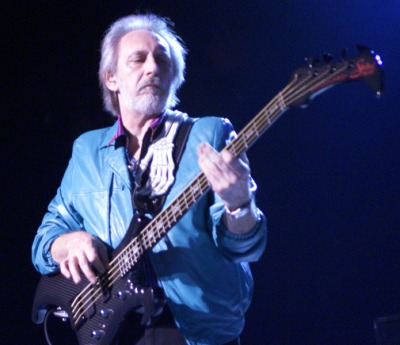
Resources and Information
Contributors
Thanks to those who have made this page possible:
- Paul Winkler (pw_lists@slinkp.com)
- Brad Rodgers (whocollection.com)
- Irwin, on behalf of the John Entwistle Foundation (archived). For more information, or to join and contribute, see johnentwistle.com (archived).
- Ray Davis (abbeyrhode.com)
- Les Chambers
Additional Information:
- Brad Rodgers at whocollection.com.
- Rock Stars Guitars, rockstarsguitars.com
- Sotheby’s May 2003 auction: sothebys.com
- History of the Buzzard Bass at warwickbass.com/news/37.htm (archived).
- buzzardbass.com (archived)
- Bass Culture, by John Entwistle; forewords by Roger Daltrey and Rick Nielsen. Published 2004 by Sanctuary Publishing.
Manufacturer’s Sites
- Warwick Basses: warwickbass.com/basses/buzzard_ltd.html (archived)
- Modulus Graphite: modulusgraphite.com
- Status Graphite basses: status-graphite.com
- MEC: mec-pickups.de
- EMG: emgpickups.com
- Bartolini: bartolini.net
- Ashdown Engineering: ashdownmusic.co.uk (archived)
- Rotosound Strings: rotosound.com
- Trace Elliot: trace-elliot.co.uk
- TC Electronic: tcelectronic.com
- Gallien-Krueger: gallien-krueger.com
- Hipshot: hipshotproducts.com
